1224

The transition to the circular economy slowed down globally last year, as the vast majority of raw materials entering economies still come from virgin sources, and the share of secondary, reused materials has been consistently decreasing over the past five years, from 9.1% in 2018 to 7.2% in 2023, according to the "CircularityGap 2024" study conducted by Deloitte and the Circle Economy Foundation.
The report indicates that the areas of intervention that could combat this trend are the agri-food industry, manufacturing, and construction sectors, which are highly polluting, major consumers of vulnerable raw materials, and together employ over three-quarters of the global workforce.
Intensive resource exploitation has been a key factor in the economic growth, living standards, and life expectancy over the last century, but the impact of the classic linear economic model (take, make, waste) has become unsustainable globally, explains the study, noting that in just the last six years, the world's economies have consumed nearly 600 billion tons of materials, almost as much as in the entire 20th century, while six out of nine planetary boundary systems, measuring the state of water, soil, and air, are irreversibly affected.
On the other hand, a sustained pace of transitions toward the circular economy (use less, use longer, make clean, use again) could contribute to reducing emissions by at least one-third and creating two million jobs, within a "circular" market that could reach $3 trillion by 2026, the report further shows.
"The study draws attention to a hard-to-ignore aspect: while the circular economy is recognized as a mega-trend that has found its place in business strategies, the figures indicating the objective progress of the transition have consistently decreased over the past five years.
In other words, transitions to the circular economic model are not keeping pace with the growing consumption demand and seem to lack a systemic character. Indeed, these are also the directions for which the report proposes action paths: on the one hand, there is a need for the priority approach of essential sectors with a high environmental impact, such as the agri-food sector, manufacturing industry, and construction, and, on the other hand, the effort must involve synergistically business actors, the public sector, and civil society.
We know from last year's edition of the same study that the circular economy can reduce current resource consumption by one-third without affecting the quantity and diversity of products and services, so sustainable transformation is possible," said Alexandru Reff, Country Managing Partner, Deloitte Romania and Moldova.
The intervention should take place on three simultaneous levels, taking into account not only environmental reasons but also factors such as the effects of the health crisis and geopolitical tensions, recommends the study. Firstly, it should include national and supranational policies, objectives, and compliance norms that would compel economic actors of all categories to begin the transition, thereby creating unitary or comparable effects along value chains. Secondly, the intervention should unfold financially, by increasing investments in transition measures – retooling, eco-design, etc. – as well as through environmental tax reform, the so-called "true cost accounting," which takes into account the business's environmental costs. Thirdly, the study emphasizes the need for continuous education and motivation of people towards a mentality of responsible and efficient living and consumption.
"Starting last year, Deloitte has been surveying the perception and implementation status of the circular economy in the local business environment within an annual study, and the conclusions of the first edition showed us that, although companies are researching, developing strategies and investment plans, and taking various measures related to optimizing the consumption of raw materials, packaging, and the design and marketing of more durable products, the effort remains rather disparate, and only half of the analyzed companies stated that changing the business model towards circularity is their objective.
Romania has one of the lowest circularity percentages in the EU, 1.4, according to Eurostat data for 2022, but, on the other hand, since 2023 we have a complete framework of regulations, policies, and programs aimed at inducing a change in mentality throughout the entire value chain, up to the end consumer, so we expect to see developments, to which, moreover, we aim to contribute with our expertise," stated Adrian Teampău, Director, Circular Economy Consulting, Deloitte Romania.
Rethinking the current model of exploitation and consumption in the logic of circularity will positively influence the so-called curve of socio-economic development globally, the study further indicates, reducing the gaps between countries and continents. Numerous regions in Africa and Southeast Asia still need to rapidly increase production capacity to reduce poverty and associated social risks.
The study categorizes these areas as Build and shows that, in their case, increasing material consumption is justified by the objective of ensuring welfare and social stability but must also be done taking into account urgent environmental issues. On the other hand, strong economies, from the Shift category (Europe, the USA, etc.), or emerging ones, from the Grow category (China, etc.), should create a so-called "ecological space" for the benefit of underdeveloped regions by reducing or stabilizing their own consumption.





